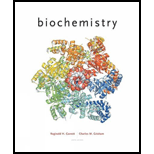
Concept explainers
Answers to all problems are at the end of this book. Detailed solutions are available in the Student Solutions Manual, Study Guide, and Problems Book.
(Research Problem) The Nature of Protein-Protein Interactions How do proteins interact? When one protein binds to another, one or both changes conformation. Two hypotheses have been proposed to describe such binding: In the induced fit model, the interaction between a protein and a ligand induces a conformation change (in the protein or ligand) through a step wise process. In the conformational selection model, the
unliganded protein (in the absence of the ligand) exists as an ensemble of conformations in a dynamic equilibrium. The binding ligand interacts preferentially with one among many of these conformations and shifts the equilibrium in favor of the selected conformation. Three recent papers shed light on this question:
Boehr, D.. and Wright, P. E., 2008. How do proteins interact? Science 320:1429-1430.
Gsponer, J.. et al., 200&. A coupled equilibrium shift mechanism in calmodulin-mediated signal transduction. Structure 16:736—'746.
Lange, O., et al., 2008. Recognition dynamics up to microseconds revealed from an R DC-derived ubiquitin ensemble in solution. Science 320:1471-1475.
Consult these papers and answer the following questions:
What proteins were studied in these papers?
What techniques were used, and what time scales of protein motion were studied?
What were the conclusions of these papers, and how do these results illuminate the choice between induced fit and conformational selection in protein-protein interactions?
Want to see the full answer?
Check out a sample textbook solution
Chapter 6 Solutions
Biochemistry
- The following data were recorded for the enzyme catalyzed conversion of S -> P. Question: Estimate the Vmax and Km. What would be the rate at 2.5 and 5.0 x 10-5 M [S] ?arrow_forwardPlease helparrow_forwardThe following data were recorded for the enzyme catalyzed conversion of S -> P Question: what would the rate be at 5.0 x 10-5 M [S] and the enzyme concentration was doubled? Also, the rate given in the table is from product accumulation after 10 minuets of reaction time. Verify these rates represent a true initial rate (less than 5% turnover). Please helparrow_forward
- The following data was obtained on isocitrate lyase from an algal species. Identify the reaction catalyzed by this enzyme, deduce the KM and Vmax , and determine the nature of the inhibition by oxaloacetate. Please helparrow_forwardIn the table below, there are sketches of four crystals made of positively-charged cations and negatively-charged anions. Rank these crystals in decreasing order of stability (or equivalently increasing order of energy). That is, select "1" below the most stable (lowest energy) crystal. Select "2" below the next most stable (next lowest energy) crystal, and so forth. A B 鹽 (Choose one) +2 C +2 +2 (Choose one) D 鹽雞 (Choose one) (Choose one)arrow_forward1. Draw the structures for the fats A. 16:2: w-3 and B. 18:3:49,12,15 2. Name each of the molecules below (image attached)arrow_forward
- draw the structures for the fats A. 16:2:w-3 B 18:3:9,12,15arrow_forward1. Below is a template strand of DNA. Show the mRNA and protein that would result. label the ends of the molecules ( refer to attached image)arrow_forwardAttach the followina labels to the diagram below: helicase, single stranded binding proteins, lagging strand, leading strand, DNA polymerase, primase, 5' ends (3), 3' ends (3) (image attached)arrow_forward
- 1. How much energy in terms of ATP can be obtained from tristearin (stearate is 18:0) Show steps pleasearrow_forwardMultiple choice urgent!!arrow_forward1. Write the transamination reaction for alanine. Indicate what happens next to each of the molecules in the reaction, and under what conditions it happens. 2.arrow_forward
 BiochemistryBiochemistryISBN:9781305577206Author:Reginald H. Garrett, Charles M. GrishamPublisher:Cengage Learning
BiochemistryBiochemistryISBN:9781305577206Author:Reginald H. Garrett, Charles M. GrishamPublisher:Cengage Learning
